

25-pair color code. Singlecore cable, 25-pair, 50 conductors.
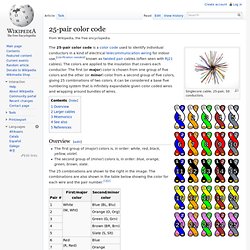
The 25-pair color code is a color code used to identify individual conductors in a kind of electrical telecommunication wiring for indoor use,[clarification needed] known as twisted pair cables (often seen with RJ21 cables). The colors are applied to the insulation that covers each conductor. The first (or major) color is chosen from one group of five colors and the other (or minor) color from a second group of five colors, giving 25 combinations of two colors. It can be considered a base five numbering system that is infinitely expandable given color coded wires and wrapping around bundles of wires. Chai (symbol) Chai Chai (Hebrew: חַי "living" ḥay) is a Hebrew word that figures prominently in modern Jewish culture; the Hebrew letters of the word are often used as a visual symbol.
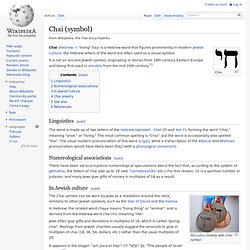
It is not an ancient Jewish symbol, originating in stories from 18th century Eastern Europe and being first used in amulets from the mid 20th century.[1] The Chai symbol can be worn by Jews as a medallion around the neck, similarly to other Jewish symbols, such as the Star of David and the Hamsa. In Hebrew, the related word chaya means "living thing" or "animal", and is derived from the Hebrew word chai (חי), meaning "life".
Jews often give gifts and donations in multiples of 18, which is called "giving chai". It appears in the slogan "ʿam yisraʾel ḥay! " In the Eurovision Song Contest 1983, which was held in Germany four decades after Shoah, Israel was represented with a song called Chai performed by Ofra Haza which included the line Am Yisra'el chai. Chai pendant. Norse cosmology. The cosmology of Norse mythology has "nine homeworlds", unified by the world tree Yggdrasill.

Mapping the nine worlds escapes precision because the Poetic Edda often alludes vaguely. The Norse creation myth tells how everything came into existence in the gap between fire and ice, and how the gods shaped the homeworld of humans. Pineal gland. The pineal gland, also known as the pineal body, conarium or epiphysis cerebri, is a small endocrine gland in the vertebrate brain.
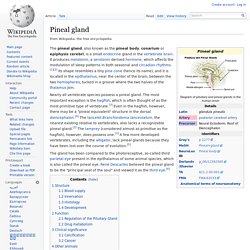
Parietal eye. The parietal eye (very small grey oval between the regular eyes) of a juvenile bullfrog (Rana catesbeiana) Adult Carolina anole (Anolis carolinensis) clearly showing the parietal eye (small grey/clear oval) at the top of its head.
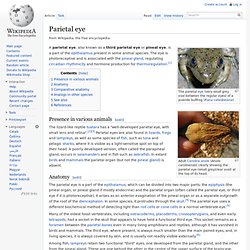
A parietal eye, also known as a third parietal eye or pineal eye, is a part of the epithalamus present in some animal species. The eye is photoreceptive and is associated with the pineal gland, regulating circadian rhythmicity and hormone production for thermoregulation.[1] Presence in various animals[edit] The lizard-like reptile tuatara has a "well-developed parietal eye, with small lens and retina".[2][3] Parietal eyes are also found in lizards, frogs and lampreys, as well as some species of fish, such as tuna and pelagic sharks, where it is visible as a light-sensitive spot on top of their head.
Combining character. Unicode also contains many precomposed characters, so that in many cases it is possible to use both combining diacritics and precomposed characters, at the user's or application's choice.
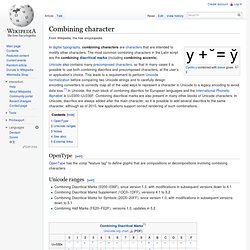
This leads to a requirement to perform Unicode normalization before comparing two Unicode strings and to carefully design encoding converters to correctly map all of the valid ways to represent a character in Unicode to a legacy encoding to avoid data loss.[1] In Unicode, the main block of combining diacritics for European languages and the International Phonetic Alphabet is U+0300–U+036F. Combining diacritical marks are also present in many other blocks of Unicode characters. In Unicode, diacritics are always added after the main character, so it is possible to add several diacritics to the same character, although as of 2010[update], few applications support correct rendering of such combinations. OpenType[edit] Unicode ranges[edit] Notes[edit] See also[edit] Dead key. Kármán vortex street.
Animation of vortex street created by a cylindrical object.
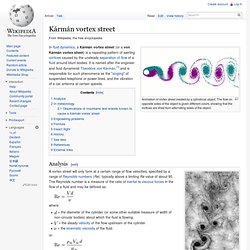
The flow on opposite sides of the object is given different colors, showing that the vortices are shed from alternating sides of the object. In fluid dynamics, a Kármán vortex street (or a von Kármán vortex sheet) is a repeating pattern of swirling vortices caused by the unsteady separation of flow of a fluid around blunt bodies. It is named after the engineer and fluid dynamicist Theodore von Kármán,[1] and is responsible for such phenomena as the "singing" of suspended telephone or power lines, and the vibration of a car antenna at certain speeds. Analysis[edit] A vortex street will only form at a certain range of flow velocities, specified by a range of Reynolds numbers (Re), typically above a limiting Re value of about 90. Where: or: In meteorology[edit] Observations of mountains and islands known to cause a Kármán vortex street[edit] Engineering problems[edit] Simulated vortex street around a no-slip cylindrical obstruction.
Nictitating membrane. The nictitating membrane (from Latin nictare, to blink) is a transparent or translucent third eyelid present in some animals that can be drawn across the eye for protection and to moisten it while maintaining visibility.

Some reptiles, birds, and sharks have full nictitating membranes; in many mammals, a small, vestigial portion of the membrane remains in the corner of the eye. Some mammals, such as camels, polar bears, seals and aardvarks, have full nictitating membranes. Often called a third eyelid or haw, it may be referred to in scientific terminology as the plica semilunaris, membrana nictitans or palpebra tertia.